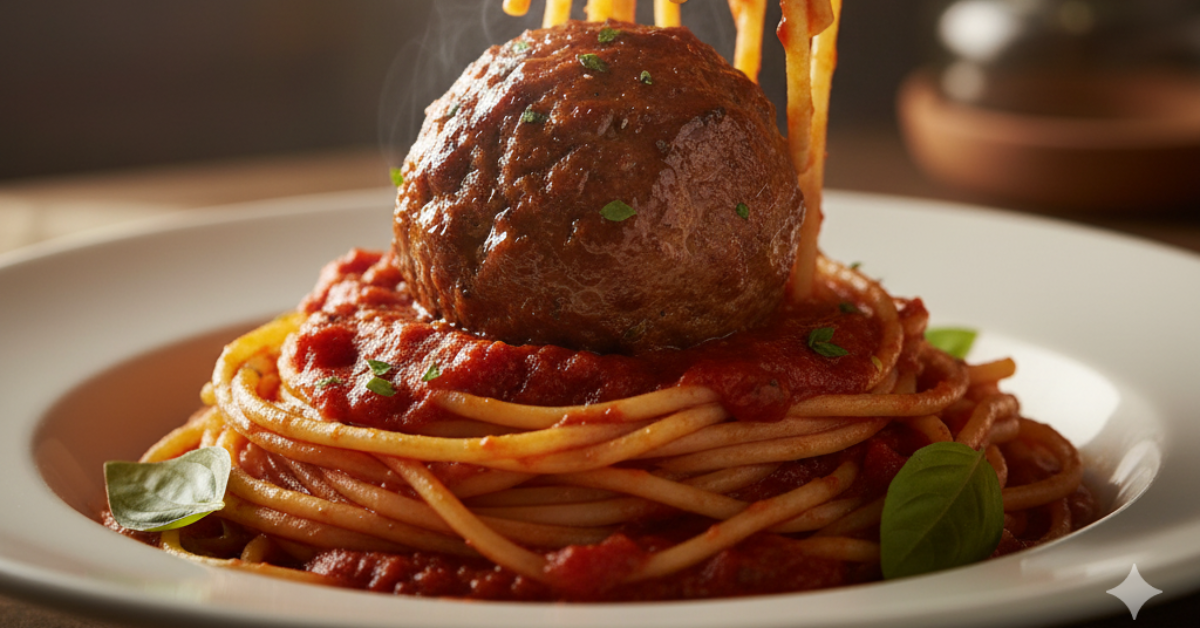The **spaghetti and meatballs** dish is the undisputed heavyweight champion of comfort food. It’s a meal that instantly transports you to a nonna’s kitchen, promising rich, slow-simmered sauce and meatballs so tender they practically melt in your mouth. But achieving that melt-in-your-mouth texture requires knowing a few critical Italian-American secrets—starting with the meat blend and ending with the perfect simmer time.
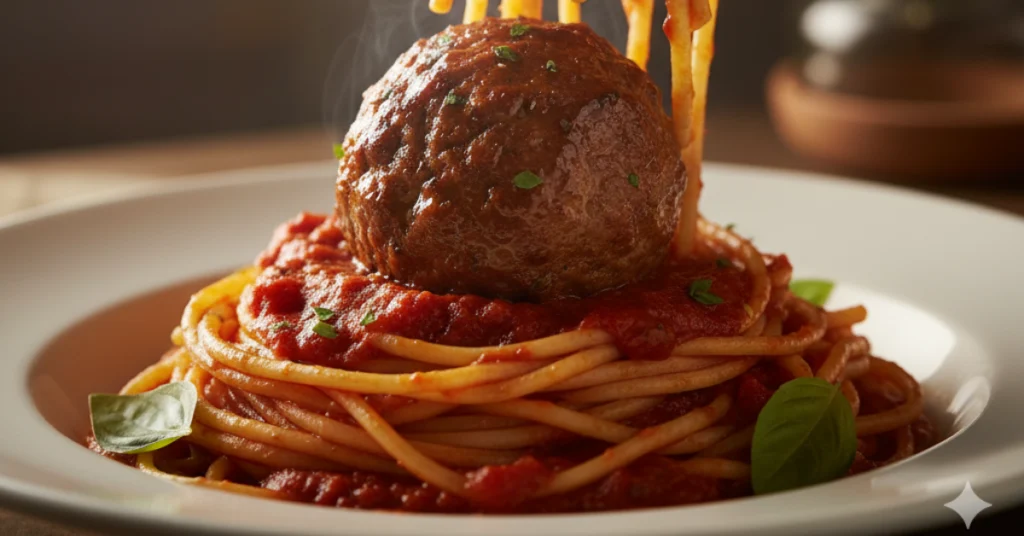
Forget the tough, dense balls of ground beef you sometimes encounter. This ultimate **spaghetti and meatballs recipe** will guide you through the process of creating light, flavorful meatballs that actually enrich the sauce as they cook. This easy, satisfying meal is a perfect fit for your **Dinner** menu and is one of the most rewarding recipes you can master.
- The Ultimate Meatball Recipe for Spaghetti and Meatballs
- Step-by-Step: How to Make Spaghetti and Meatballs
- Deep Dive: The Science of Simmering vs. Serving
- Spaghetti and Meatballs: Variations and Pairings
- Cultural Notes and Final Pro Tips
- FAQ: Your Questions About Spaghetti and Meatballs
- Conclusion: The Ultimate Comfort Food Recipe
- Recipe Summary: Ultimate Spaghetti and Meatballs
- Steps to Follow (How to Make Spaghetti and Meatballs)
- Tools You’ll Need
The Ultimate Meatball Recipe for Spaghetti and Meatballs
The secret to tender, soft **meatballs for spaghetti and meatballs** is the *panade*—a mixture of milk-soaked bread. This simple technique, combined with the right meat blend, guarantees a light, juicy texture.
The Perfect Meat Blend for Tender Meatballs:
Most experts agree that the best flavor and texture come from a three-meat blend, although two are acceptable. This blend provides richness, tenderness, and structure, which straight ground beef often lacks.
- **Beef (1 lb):** Chuck or $80/20$ ground beef provides the classic savory base.
- **Pork ($\frac{1}{2}$ lb):** Ground pork adds essential fat and richness, keeping the meatballs moist.
- **Veal ($\frac{1}{2}$ lb, Optional):** Ground veal (if available) adds a subtle sweetness and velvety texture that truly elevates the **spaghetti and meatballs recipe**.
The Secret to Tender Meatballs: The Panade
The panade (bread soaked in milk or water) is the insurance policy against tough meatballs. The starch in the bread absorbs the liquid, forming a gel that prevents the meat proteins from tightening up and seizing during cooking. This technique ensures your **meatball recipe for spaghetti** is soft and spongy.
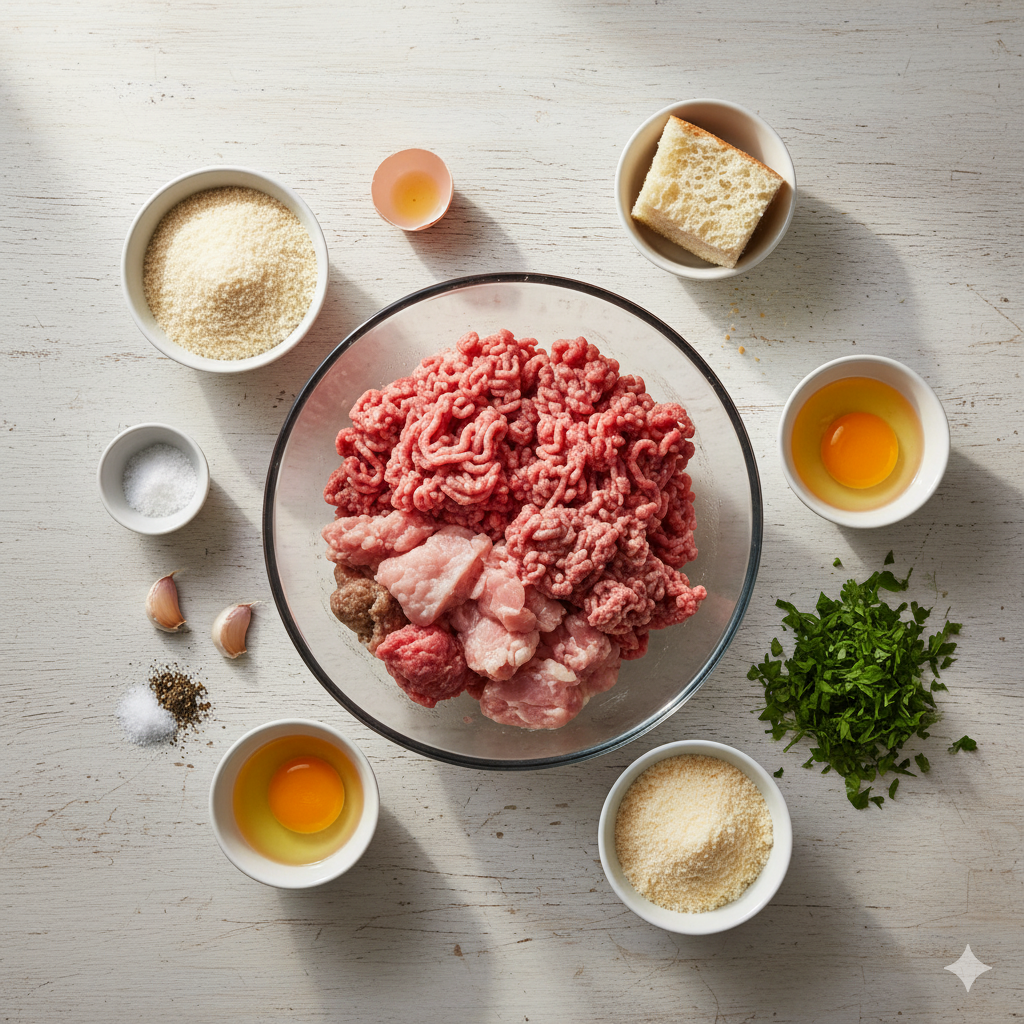
Step-by-Step: How to Make Spaghetti and Meatballs
The process of making this dish requires two separate phases: preparing the meatballs and developing the rich sauce. The final step is simmering the two together to create an unforgettable, unified flavor.
Mixing and Forming the Meatballs:
- **Combine Flavorings:** In a large bowl, mix the panade, eggs, grated cheese (Parmesan/Romano), minced garlic, and fresh herbs (parsley/basil) until well combined.
- **Add Meat:** Gently add the ground meats (beef, pork, veal). Mix with your hands just until everything is combined. **Do not overmix**, as overworking the meat makes it tough.
- **Form:** Roll the mixture into golf ball-sized balls (about 1.5 inches). This recipe makes approximately 18–20 meatballs.
Developing the Sauce and Simmering the Meatballs:
The **how to make spaghetti and meatballs** process hinges on cooking the meatballs in the sauce to enrich the final flavor.
- **Brown Meatballs:** Brown the outside of the meatballs in a skillet with olive oil over medium-high heat until they have a nice crust. Remove the meatballs, but keep the pan drippings for the sauce.
- **Build Sauce Base:** In the same pot, sauté diced onions and garlic in the drippings. Add crushed tomatoes, tomato paste, wine (if using), and dried herbs. Simmer this base for at least 30 minutes (or up to 2 hours) to deepen the flavor.
- **Final Simmer:** Gently add the browned meatballs into the simmering sauce. Cover and let them cook for just 30 minutes. This final simmer ensures the meatballs are cooked through and the juices infuse the sauce, without leaving the meat tough.
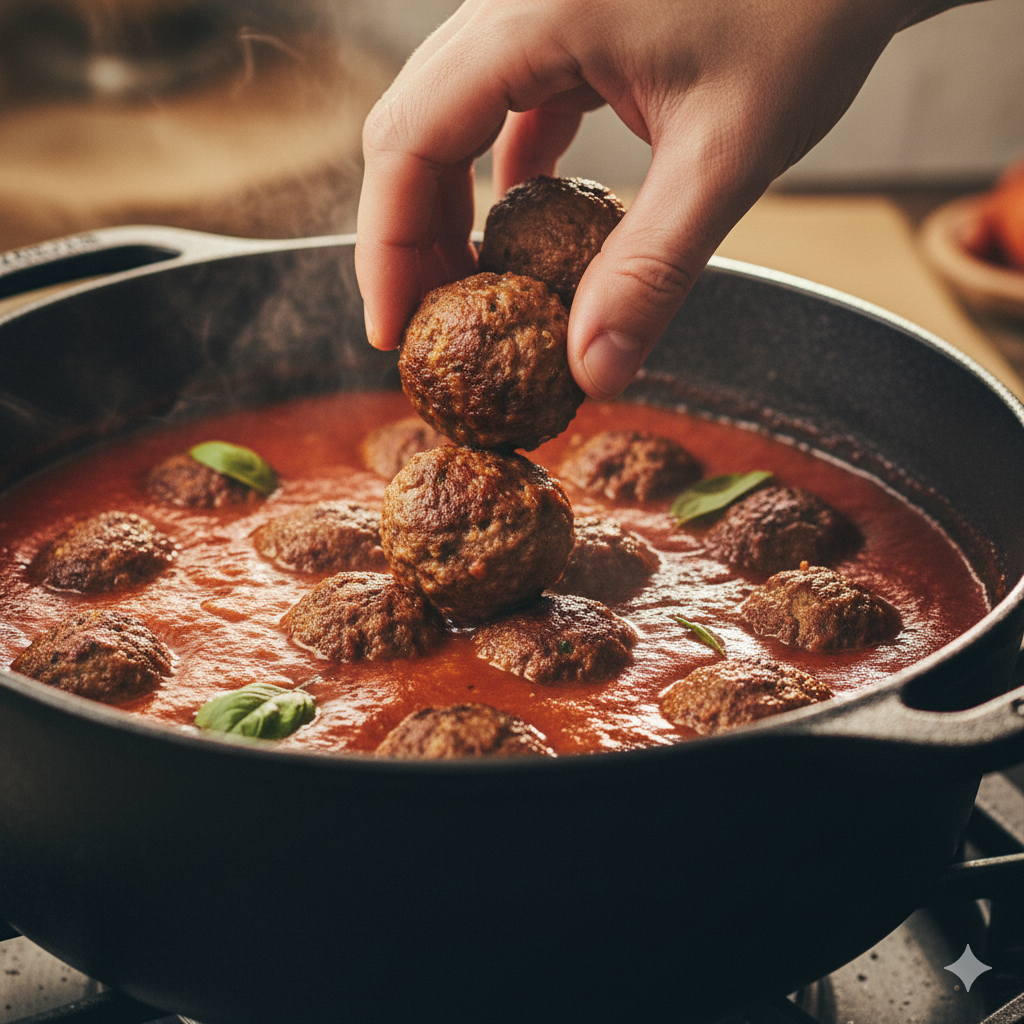
Deep Dive: The Science of Simmering vs. Serving
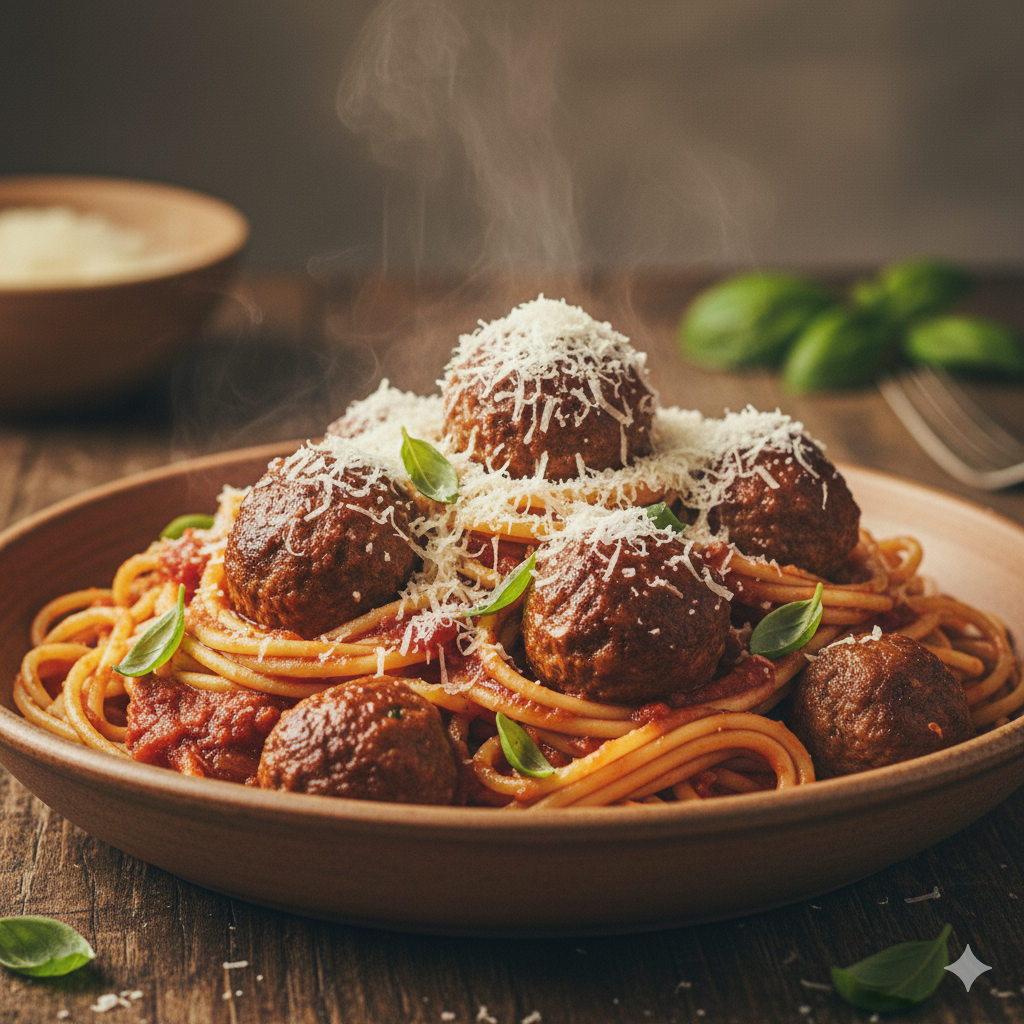
The debate among Italian-American cooks over how long to simmer the meatballs is intense. Traditional recipes often call for two or more hours, but modern culinary science suggests a shorter time is better for the *meatball* texture.
When beef proteins are exposed to heat for too long, they contract and squeeze out moisture, leading to a tough and dry texture. Experts now suggest that the sauce should be simmered *first* to develop its flavor (up to 2 hours), and the meatballs should only be added for a final 30–45 minutes of simmering. This allows the panade to work its magic, keeping the meatballs tender while the sauce thickens and absorbs just enough flavor. The long paragraph below details the complex balance required for this ultimate **spaghetti and meatballs recipe**.
The key to mastering this **spaghetti and meatballs recipe** is realizing that the long simmer is for the *sauce*, not the meat. If you desire a deeply complex, non-acidic sauce, you should simmer the tomato base with aromatics and herbs for 1 to 2 hours *before* the meatballs are added. The meatballs, already partially cooked from the browning step, require only about 30 minutes in the hot sauce to reach the optimal internal temperature of $160^\circ\text{F}$ and infuse their juices into the liquid. Over-simmering beyond this point causes the panade to break down excessively and the meat proteins to tighten, resulting in tough, dry meatballs that feel gritty.
The secret to the **best spaghetti and meatballs** is removing the meatballs from the sauce once they are perfectly tender and holding them warm, while allowing the sauce to continue simmering to your desired consistency.
This two-stage cooking process—separating the intense heat/simmer time for the sauce and the minimal cook time for the meat—is a contemporary technique that honors the traditional flavors while guaranteeing a melt-in-your-mouth texture, which is the hallmark of a high-quality dish. To prevent the meatballs from falling apart during the final 30-minute simmer, ensure you brown them aggressively first; the sear creates a strong, firm exterior that holds the tender interior intact. For more detailed tips on managing meatball texture, Serious Eats offers excellent scientific guidance, emphasizing a short simmer time for tenderness.
Spaghetti and Meatballs: Variations and Pairings
Recipe Variations:
- **Baked Meatballs:** Instead of pan-frying, bake the meatballs on a parchment-lined sheet at $400^\circ\text{F}$ for 15-20 minutes until browned, then add them to the sauce. This reduces the fat content and mess.
- **Lighter Meatballs:** Substitute the pork and veal with ground turkey. To maintain moisture, use an extra tablespoon of milk in the panade.
- **Sauce Variations:** Enhance the sauce with a splash of red wine or a parmesan rind during the simmering process for extra depth.
Serving and Pairings:
No dish is complete without a side. Serve your **spaghetti and meatballs** with a simple side of garlic bread and a light green salad.
- **Appetizer:** Start your meal with a cool, savory appetizer like our Spinach Dip Recipe, which offers a great contrast to the richness of the pasta.
- **Side:** A classic pairing is a simple **Quick Recipes** side dish, such as our crunchy Roasted Potatoes Recipe, which provides a satisfying textural contrast.
- **Wine:** A dry red wine, such as Chianti or Sangiovese, pairs perfectly with the acidity of the tomato sauce.
Cultural Notes and Final Pro Tips
It is important to note that **spaghetti and meatballs** is not an authentic Italian dish. It is a famous Italian-American invention created by Italian immigrants who adapted their smaller, traditional *polpettes* (meatballs) and served them over spaghetti, making the dish a hearty, large-portioned meal for their new home. This cultural adaptation highlights the resourcefulness and comfort inherent in the American culinary tradition. For more on the correct cultural cooking time of meatballs, check out the scientific advice from Serious Eats.
For an alternative to the traditional **Dinner** experience, you can serve leftover meatballs and sauce in a sandwich on a toasted hoagie roll, much like our popular **[Philly Cheesesteak Recipe]** (https://flavorillarecipes.com/philly-cheesesteak-recipe).
FAQ: Your Questions About Spaghetti and Meatballs
How do you make meatballs for spaghetti and meatballs?
To make tender **meatballs for spaghetti and meatballs**, combine a mix of ground beef, pork, and optional veal with a panade (milk-soaked bread or breadcrumbs), egg, grated cheese, and fresh herbs. Mix gently to avoid overworking the meat, and form into uniform balls before browning or baking.
How to make spaghetti and meatballs?
To **how to make spaghetti and meatballs**, prepare the meatballs and a rich tomato sauce separately. Cook the meatballs (by frying, baking, or simmering raw) and add them to the sauce for a final 30-45 minute simmer to meld flavors, then serve over al dente spaghetti.
What is the secret to getting tender meatballs for spaghetti?
The secret is using a panade—a mushy mixture of bread soaked in milk or water. The starches in the panade absorb and retain moisture during cooking, physically breaking up the meat proteins to prevent them from seizing, which results in a soft, melt-in-your-mouth texture.
How long should I simmer the meatballs in the sauce?
To maintain maximum tenderness, meatballs should only simmer in the sauce for about 30-45 minutes after they are browned or fully cooked. Simmering them for hours, while traditional for sauce development, will cause the meat to dry out and become tough.
Conclusion: The Ultimate Comfort Food Recipe
The **spaghetti and meatballs recipe** is a rewarding culinary endeavor that brings authentic Italian-American comfort into your home. By utilizing the panade technique and controlling the final simmer time, you guarantee a melt-in-your-mouth experience that is far superior to any pre-made alternative.
This **ultimate classic comfort recipe** is perfect for your **Dinner** repertoire. Embrace the process, serve generously, and enjoy the rich, satisfying flavor that has made **spaghetti and meatballs** a global icon.
Recipe Summary: Ultimate Spaghetti and Meatballs
→ Meatballs (Makes 18–20)
- 1 lb Ground Beef (80/20)
- ½ lb Ground Pork
- ½ lb Ground Veal (optional)
- 1 cup Fresh Bread, crusts removed, soaked in ½ cup Milk (Panade)
- 2 large Eggs
- ½ cup Grated Pecorino Romano or Parmesan Cheese
- 4 cloves Garlic, minced
- 2 Tbsp Fresh Parsley, chopped
- 1 tsp Salt and $\frac{1}{2}$ tsp Black Pepper
→ Sauce
- 2 Tbsp Olive Oil
- 1 large Onion, diced
- 2 (28 oz) cans Crushed Tomatoes
- 1 Bay Leaf, Dried Herbs (Basil, Oregano)
- Pinch of sugar (to balance acidity)
Steps to Follow (How to Make Spaghetti and Meatballs)
- Soak bread in milk for 5 minutes. Combine panade, eggs, cheese, herbs, and seasoning. Gently mix in the ground meats until just combined. Form into 1.5-inch balls.
- Brown meatballs in olive oil in a large pot until a crust forms. Remove and set aside.
- In the same pot, sauté onion and garlic. Add crushed tomatoes, herbs, and sugar. Simmer sauce for at least 30 minutes (or longer for deeper flavor).
- Gently add the browned meatballs to the sauce. Simmer for a final 30 minutes until meatballs are cooked through and tender.
- Cook spaghetti. Serve meatballs and sauce over spaghetti, topped with fresh cheese.
Tools You’ll Need
- Large Dutch Oven or Pot
- Mixing bowls (2)
- Slotted spoon and tongs

